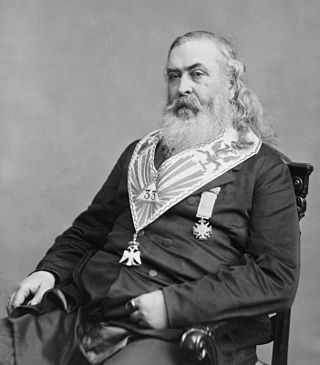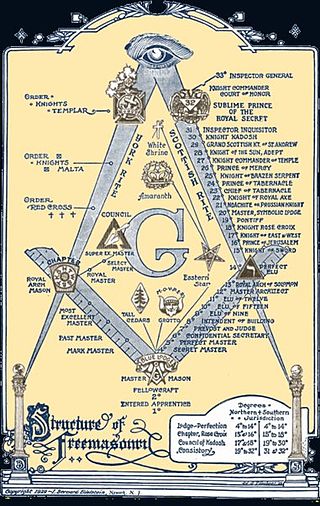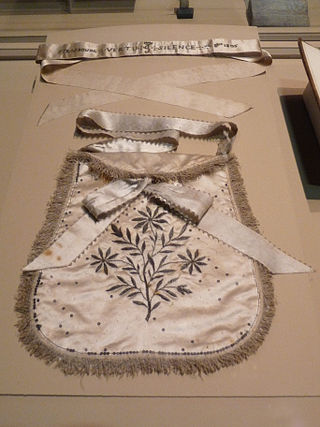
Albert Pike was an American author, poet, orator, editor, lawyer, jurist and Confederate States Army general who served as an associate justice of the Arkansas Supreme Court in exile from 1864 to 1865. He had previously served as a senior officer of the Confederate States Army, commanding the District of Indian Territory in the Trans-Mississippi Theater. A prominent member of the Freemasons, Pike served as the Sovereign Grand Commander of the Supreme Council, Scottish Rite from 1859 to 1891.

Freemasonry or Masonry refers to fraternal organisations that trace their origins to the local guilds of stonemasons that, from the end of the 13th century, regulated the qualifications of stonemasons and their interaction with authorities and clients. Modern Freemasonry broadly consists of two main recognition groups:

A secret society is an organization whose activities, events, inner functioning, or membership are concealed. The society may or may not attempt to conceal its existence. The term usually excludes covert groups, such as intelligence agencies or guerrilla warfare insurgencies, that hide their activities and memberships but maintain a public presence.

The Independent Order of Odd Fellows (IOOF) is a non-political and non-sectarian international fraternal order of Odd Fellowship. It was founded in 1819 by Thomas Wildey in Baltimore, Maryland, United States. Evolving from the Order of Odd Fellows founded in England during the 18th century, the IOOF was originally chartered by the Independent Order of Oddfellows Manchester Unity in England but has operated as an independent organization since 1842, although it maintains an inter-fraternal relationship with the English Order. The order is also known as the Triple Link Fraternity, referring to the order's "Triple Links" symbol, alluding to its motto "Friendship, Love and Truth".

The Independent Order of Rechabites (IOR), also known as the Sons and Daughters of Rechab, is a fraternal organisation and friendly society founded in England in 1835 as part of the wider temperance movement to promote total abstinence from alcoholic beverages. Always well connected in upper society and involved in financial matters, it gradually transformed into a financial institution which still exists, and still promotes abstinence. The Order has been active in Australia from 1843, promoting temperance and as a benefit society. A branch was established in the United States in 1842, and also flourished for a time. In the United Kingdom, the Order trades under the name of Healthy Investment.
Hundreds of conspiracy theories about Freemasonry have been described since the late 18th century. Usually, these theories fall into three distinct categories: political, religious, and cultural. Many conspiracy theories have connected the Freemasons with worship of the devil; these ideas are based on different interpretations of the doctrines of those organizations.

Odd Fellows is an international fraternity consisting of lodges first documented in 1730 in London. The first known lodge was called Loyal Aristarcus Lodge No. 9, suggesting there were earlier ones in the 18th century. Notwithstanding, convivial meetings were held "in much revelry and, often as not, the calling of the Watch to restore order." Names of several British pubs today suggest past Odd Fellows affiliations. In the mid-18th century, following the Jacobite risings, the fraternity split into the rivaling Order of Patriotic Oddfellows in southern England, favouring William III of England, and the Ancient Order of Oddfellows in northern England and Scotland, favouring the House of Stuart.

A benefit society, fraternal benefit society, fraternal benefit order, friendly society, or mutual aid society is a society, an organization or a voluntary association formed to provide mutual aid, benefit, for instance insurance for relief from sundry difficulties. Such organizations may be formally organized with charters and established customs, or may arise ad hoc to meet unique needs of a particular time and place.

The Templars of Honor and Temperance established in the United States in 1845 as the Marshall Temperance Fraternity as part of the temperance movement. The Templars were formed as a result of a schism within the older Sons of Temperance, when some felt that the organization did not have an elaborated enough ritual. The new group changed its name several times, first to "Marshall Temple, No. 1, Sons of Honor", then to "Marshall Temple of Honor, No. 1, Sons of Temperance". In 1846, the National Temple of the Templars of Honor and Temperance of the United States was instituted in New York.

Grand Master a title of the supreme head of various orders, including chivalric orders such as military orders and dynastic orders of knighthood.

There are many organisations and orders which form part of the widespread fraternity of Freemasonry, each having its own structure and terminology. Collectively these may be referred to as Masonic bodies, Masonic orders or appendant bodies of Freemasonry.
A fraternal order is a fraternity organised as an order, with traits alluding to religious, chivalric or pseudo-chivalric orders, guilds, or secret societies. Contemporary fraternal orders typically have secular purposes, including social, cultural and mutually beneficial or charitable aims. Many friendly societies, benefit societies and mutual organisations take the form of a fraternal order.
The Order of United American Mechanics was an anti-Catholic American Nativist organization of the mid-19th century. It was founded in Philadelphia amid the anti-alien riots of 1844-45. It originally was called the Union of Workers. Members were required to undertake efforts to publicize and campaign against the hiring of cheap foreign labor and to patronize only "American" businesses.

Freemasonry has had a complex relationship with women, which can be readily divided into many phases with no demonstrable relationship to each other until the 20th century. A few women were involved in Freemasonry before the 18th century; however the first printed constitutions of the Premier Grand Lodge of England appeared to bar them from the Craft forever.

A fraternity or fraternal organization is an organization, society, club or fraternal order traditionally of men associated together for various religious or secular aims. Fraternity in the Western concept developed in the Christian context, notably with the religious orders in the Catholic Church during the Middle Ages. The concept was eventually further extended with medieval confraternities and guilds. In the early modern era, these were followed by fraternal orders such as Freemasons and Odd Fellows, along with gentlemen's clubs, student fraternities, and fraternal service organizations. Members are occasionally referred to as a brother or – usually in a religious context – Frater or Friar.
Freemasonry in the United States is the history of Freemasonry as it was introduced from Britain and continues as a major secret society to the present day. It is a fraternal order that brings men together to gain friendship and opportunity for advancement and community progress. It has been nonpolitical except for a period around 1820 when it came under heavy attack in the Northeast. That attack reduced membership, but it recovered and grew after 1850. Growth ended in the late 20th century and membership has declined.












